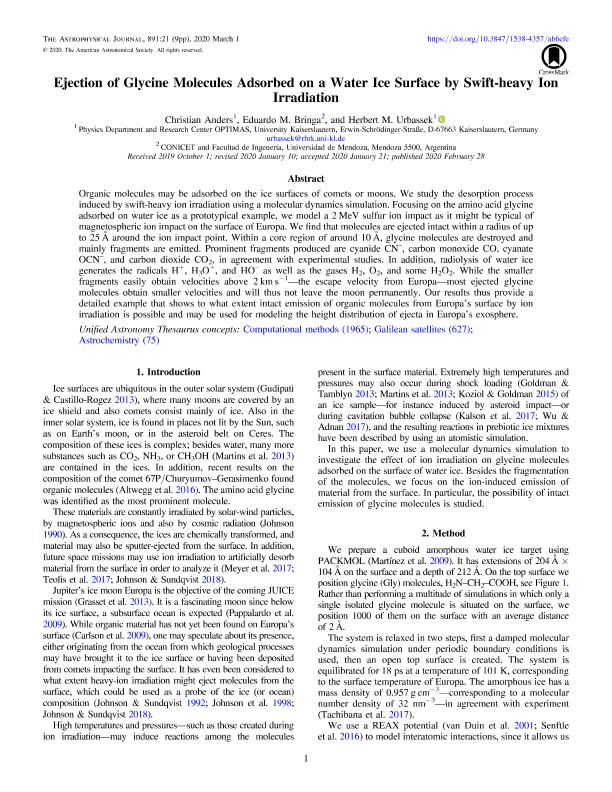Mostrar el registro sencillo del ítem
dc.contributor.author
Anders, Christian

dc.contributor.author
Bringa, Eduardo Marcial

dc.contributor.author
Urbassek, Herbert M.

dc.date.available
2021-10-21T11:22:47Z
dc.date.issued
2020-03
dc.identifier.citation
Anders, Christian; Bringa, Eduardo Marcial; Urbassek, Herbert M.; Ejection of Glycine Molecules Adsorbed on a Water Ice Surface by Swift-heavy Ion Irradiation; IOP Publishing; Astrophysical Journal; 891; 1; 3-2020; 1-9
dc.identifier.issn
0004-637X
dc.identifier.uri
http://hdl.handle.net/11336/144566
dc.description.abstract
Organic molecules may be adsorbed on the ice surfaces of comets or moons. We study the desorption process induced by swift-heavy ion irradiation using a molecular dynamics simulation. Focusing on the amino acid glycine adsorbed on water ice as a prototypical example, we model a 2 MeV sulfur ion impact as it might be typical of magnetospheric ion impact on the surface of Europa. We find that molecules are ejected intact within a radius of up to 25 Å around the ion impact point. Within a core region of around 10 Å, glycine molecules are destroyed and mainly fragments are emitted. Prominent fragments produced are cyanide CN-, carbon monoxide CO, cyanate OCN-, and carbon dioxide CO2, in agreement with experimental studies. In addition, radiolysis of water ice generates the radicals H+, H3O+, and HO- as well as the gases H2, O2, and some H2O2. While the smaller fragments easily obtain velocities above 2 km s-1 - the escape velocity from Europa - most ejected glycine molecules obtain smaller velocities and will thus not leave the moon permanently. Our results thus provide a detailed example that shows to what extent intact emission of organic molecules from Europa's surface by ion irradiation is possible and may be used for modeling the height distribution of ejecta in Europa's exosphere.
dc.format
application/pdf
dc.language.iso
eng
dc.publisher
IOP Publishing

dc.rights
info:eu-repo/semantics/openAccess
dc.rights.uri
https://creativecommons.org/licenses/by-nc-sa/2.5/ar/
dc.subject
MOLECULAR DYNAMICS
dc.subject
GLYCINE
dc.subject
SPUTTERING
dc.subject.classification
Astronomía

dc.subject.classification
Ciencias Físicas

dc.subject.classification
CIENCIAS NATURALES Y EXACTAS

dc.title
Ejection of Glycine Molecules Adsorbed on a Water Ice Surface by Swift-heavy Ion Irradiation
dc.type
info:eu-repo/semantics/article
dc.type
info:ar-repo/semantics/artículo
dc.type
info:eu-repo/semantics/publishedVersion
dc.date.updated
2021-09-06T19:55:22Z
dc.journal.volume
891
dc.journal.number
1
dc.journal.pagination
1-9
dc.journal.pais
Reino Unido

dc.journal.ciudad
Londres
dc.description.fil
Fil: Anders, Christian. Technische Universität Kaiserslautern; Alemania
dc.description.fil
Fil: Bringa, Eduardo Marcial. Universidad de Mendoza; Argentina. Consejo Nacional de Investigaciones Científicas y Técnicas. Centro Científico Tecnológico Conicet - Mendoza; Argentina
dc.description.fil
Fil: Urbassek, Herbert M.. Technische Universität Kaiserslautern; Alemania
dc.journal.title
Astrophysical Journal

dc.relation.alternativeid
info:eu-repo/semantics/altIdentifier/url/https://iopscience.iop.org/article/10.3847/1538-4357/ab6efe/meta
dc.relation.alternativeid
info:eu-repo/semantics/altIdentifier/doi/http://dx.doi.org/10.3847/1538-4357/ab6efe
Archivos asociados
